Connect to VPN Gate by Using L2TP/IPsec VPN Protocol
This document describes how to connect to a VPN Relay
Server of VPN Gate by using the L2TP/IPsec VPN Client which
is bundled with the operating system.
L2TP/IPsec VPN Client is built-in on Windows, Mac, iOS
and Android. It is easier to configure than
using OpenVPN. L2TP/IPsec
VPN is recommended before you try to use OpenVPN. However,
some networks or firewalls block L2TP/IPsec packets. If
L2TP/IPsec fails, try OpenVPN.
Connecting parameters for L2TP/IPsec VPN
You can quickly configure your L2TP/IPsec VPN Client by
using the following parameters if you have already known how
to set up.
Select your OS
VPN on Windows step by step guide (Using L2TP/IPsec VPN)
Here is the instruction how to connect to a VPN Gate
Public VPN Relay Server by using L2TP/IPsec VPN Client which
is built-in on Windows XP, 7, 8, 10, RT, Server 2003, 2008 and
2012.
-
SoftEther VPN Client is
recommended on Windows.
L2TP/IPsec Client configurations are difficult than
SoftEther VPN Client.
If you are using Windows, using SoftEther VPN Client is
recommended because it is very easy to configure and
stable. SoftEther VPN Client can show the list of
currently running VPN Gate Servers on the software
screen.
On this instruction, we use Windows 7 screens. Windows XP
and Windows 8 are similar, however there are a little number
of changes.
1. Initial configurations (only once at the first time)
Right-click the network icon on the bottom-right side of
Windows screen, and click "Open Network and Sharing
Center" .

Click "Set up a new connection or network"
on the "Network Sharing Center" .

Select "Connect to a workplace" .

Select "Use my Internet connection (VPN)"
.

Open the VPN Servers List
page and choose a VPN Server which you want to connect.
Copy the DDNS Hostname (an identifier ends with ".opengw.net"
) or IP Address (digits as xxx.xxx.xxx.xxx) and paste it on
the "Internet address" field on the
configuration wizard.
- In general, DDNS Hostname (an identifier ends with
".opengw.net" ) are recommended to specify. DDNS
hostname can continue to be used even if the
corresponding IP address of the DDNS hostname will
change in future. However, in some countries or regions,
you might be unable to use DDNS hostname. If you fails
to specify a DDNS hostname, try IP Address (digits as
xxx.xxx.xxx.xxx) specification instead.
After you paste the "Internet address" , check
"Don't connect now; just set up so I can connect later"
checkbox on the bottom of the screen surely.

If the username and password prompting screen appears,
input "vpn" (3-letters) on both username
and password field. You should check "Remember this
password" .

When "The connection is ready to use" message appears,
click the "Close" button. Do not click the
"Connect now" button.

Go to "Network and Sharing Center" and click
"Change adapter settings" .

The currently defined VPN connection settings are listed.
Right click the icon you created in the previous step, and
click "Properties" .

On the Properties screen, switch to the
"Security" tab. (In Windows XP, switch to the
"Network" tab.) Choose "Layer 2 Tunneling Protocol
with IPsec (L2TP/IPSec)" on the "Type of
VPN" drop-down list.

Next, click the "Advanced settings"
button. (In Windows XP, click the "IPsec Settings" on the
"Security" tab.)
The following screen will appear. Click "Use preshared
key for authentication" and input "vpn" (3-letters) on the
"Key" field.

After the above configuration finished, click the "OK"
button twice to close the property screen of the VPN
connection setting.
2. Connect to the VPN Server
Double-click the created VPN connection setting, the
below screen will appear.
"User name" and "Password" fields should be filled
automatically if you enable password-saving options in
previous steps. If not, input "vpn" on both
"User name" and "Password" fields.

Click the "Connect" button to start the VPN connecting
attempts.
While the VPN is trying to be established, the following
screen displays statuses. If an error occurs, confirm your
settings make sure that the type of VPN is "L2TP/IPsec" ,
and the pre-shared key is correctly specified.

If the VPN connection is successfully established, a VPN
connection icon will be listed on the screen which appears
when you click the network icon on the bottom-right of
Windows screen. The status of the VPN connection icon should
be "Connected" .
By the way, you can initiate the VPN connection by simply
clicking this VPN icon from now on.

3. Enjoy Internet via VPN relaying
While VPN is established, all communications towards the
Internet will be relayed via the VPN Server. You can verify
that by using "tracert 8.8.8.8" command on
the Windows Command Prompt.

As the above figure, if the packet-path are through
"10.211.254.254" , your communication is now relayed via one
of VPN Gate Public VPN Servers.
You can also visit the VPN Gate Top Page
to see your current global IP address. You can see your
source country or region has been changed to other if you
are connecting to a VPN server which is located on oversea
country.

Enjoy YouTube, Facebook or Twitter while your VPN
connection is established.
Facebook, Twitter and Gmail uses HTTPS (SSL) encrypted
communication protocols. Regardless of VPN or non-VPN, no
one can tap these encrypted communications.
VPN on Mac step by step guide (Using L2TP/IPsec VPN)
Here is an instruction how to connect to a VPN Gate
Public VPN Relay Server by using L2TP/IPsec VPN Client which
is built-in on Mac OS X.
On this instruction, every screen-shots are taken on Mac
OS X Mountain Lion. Other versions of Mac OS X are similar
to be configured, however there might be minor different on
UIs.
These screen-shots are in English version of Mac OS X. If
you use other language, you can still configure it easily by
referring the following instructions.
1. Initial configurations (only once at the first time)
Click the network icon on the top-right side on the Mac
screen. Click "Open Network Preferences..."
in the menu.

Click the "+" button on the network
configuration screen.

Select "VPN" as "Interface"
, "L2TP over IPsec" as "VPN Type"
and click the "Create" button.

A new L2TP VPN configuration will be created, and the
configuration screen will appear.
On this screen, you have to specify either hostname or IP
address of the destination VPN Gate Public VPN Relay Server.
Open the VPN Servers List
page, and click one VPN Relay Server which you want to use.
Copy the DDNS Hostname (an identifier ends with ".opengw.net"
) or IP Address (digits as xxx.xxx.xxx.xxx) and paste it on
the "Server Address" field on the
configuration screen.
- In general, DDNS Hostname (an identifier ends with
".opengw.net" ) are recommended to specify. DDNS
hostname can continue to be used even if the
corresponding IP address of the DDNS hostname will
change in future. However, in some countries or regions,
you might be unable to use DDNS hostname. If you fails
to specify a DDNS hostname, try IP Address (digits as
xxx.xxx.xxx.xxx) specification instead.
After you specified the "Server Address"
, input "vpn" (3-letters) on the "Account Name"
field, which is the next to the "Server Address" field.
Next, click the "Authentication Settings..."
button.

The authentication screen will appear. Input "vpn"
(3-letters) to the "Password" field.
Specify "vpn" (3-letters) also on the
"Shared Secret" field. After you input
them, click the "OK" button.

After return to the previous screen, check the
"Show VPN status in menu bar" and click the
"Advanced..." button.

The advanced settings will be appeared. Check the
"Send all traffic over VPN connection" and click
the "OK" button.

On the VPN connection settings screen, click the
"Connect" button to start the VPN connection.
2. Start a VPN connection
You can start a new VPN connection by clicking the
"Connect" button at any time. You can also
initiate a VPN connection by clicking the VPN icon on the
menu bar.
After the VPN connection will be established, the VPN
connection setting screen will become as below as the
"Status" will be "Connected" . Your private
IP address on the VPN, and connect duration time will be
displayed on the screen.

3. Enjoy Internet via VPN relaying
While VPN is established, all communications towards the
Internet will be relayed via the VPN Server.
You can visit the VPN Gate Top Page to see
your current global IP address. You can see your source
country or region has been changed to other if you are
connecting to a VPN server which is located on oversea
country.

Enjoy YouTube, Facebook or Twitter while your VPN
connection is established.
Facebook, Twitter and Gmail uses HTTPS (SSL) encrypted
communication protocols. Regardless of VPN or non-VPN, no
one can tap these encrypted communications.
VPN on iPhone / iPad step by step guide (Using
L2TP/IPsec VPN)
Here is an instruction how to connect to a VPN Gate
Public VPN Relay Server by using L2TP/IPsec VPN Client which
is built-in on iPhone / iPad.
On this instruction, every screen-shots are taken on iOS
6. Other versions of iOS are similar to be configured,
however there might be minor different on UIs.
These screen-shots are in English version of iOS. If you
use other language, you can still configure it easily by
referring the following instructions.
1. Initial configurations (only once at the first time)
From the iOS main screen, start the "Settings"
application.
Open "VPN" in "General" ,
and tap "Add VPN Configuration..." .
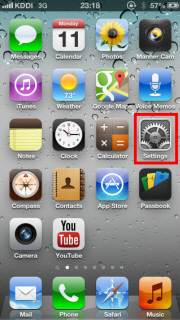
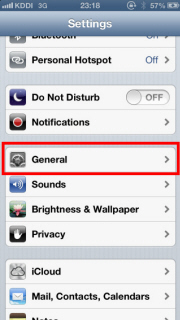
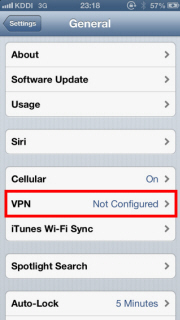
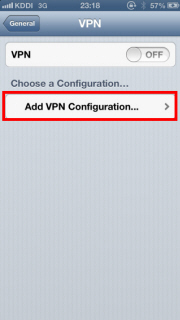
A new L2TP VPN connection setting will be created, and
the configuration screen will appear.
On this screen, you have to specify either hostname or IP
address of the destination VPN Gate Public VPN Relay Server.
Open the VPN Servers List
page, and click one VPN Relay Server which you want to use.
Copy the DDNS Hostname (an identifier ends with ".opengw.net"
) or IP Address (digits as xxx.xxx.xxx.xxx) and paste it on
the "Server" field on the configuration
screen.
- In general, DDNS Hostname (an identifier ends with
".opengw.net" ) are recommended to specify. DDNS
hostname can continue to be used even if the
corresponding IP address of the DDNS hostname will
change in future. However, in some countries or regions,
you might be unable to use DDNS hostname. If you fails
to specify a DDNS hostname, try IP Address (digits as
xxx.xxx.xxx.xxx) specification instead.
After you specify the "Server" field,
you have to input "vpn" (3-letters) to "Account"
, "Password" and "Secret"
fields. After input, tap "Save" .
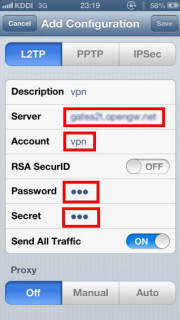
2. Connect a VPN
You can start a VPN connection by using a created VPN
connection setting at any time.
Tap the "OFF" button to initiate a VPN
connection.
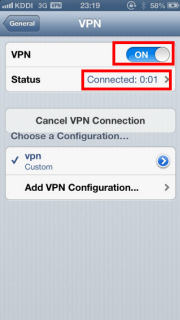
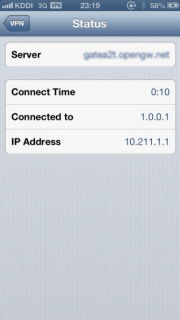
While VPN is established, you can see the status and
connect time on the status screen. Your private IP address
in VPN is also displayed. The "Connect to" IP address
reports "1.0.0.1" , but it is not an unusual.
3. Enjoy Internet via VPN relaying
While VPN is established, all communications towards the
Internet will be relayed via the VPN Server.
You can visit the VPN Gate Top Page to see
your current global IP address. You can see your source
country or region has been changed to other if you are
connecting to a VPN server which is located on oversea
country.
iOS displays the "VPN" indicator on the
top bar of the screen while VPN is established.

Enjoy YouTube, Facebook or Twitter while your VPN
connection is established.
Facebook, Twitter and Gmail uses HTTPS (SSL) encrypted
communication protocols. Regardless of VPN or non-VPN, no
one can tap these encrypted communications.
VPN on Android step by step guide (Using L2TP/IPsec VPN)
Here is an instruction how to connect to a VPN Gate
Public VPN Relay Server by using L2TP/IPsec VPN Client which
is built-in on Android.
On this instruction, every screen-shots are taken on
Android 4.x. Other versions of Android 4.x are similar to be
configured, however there might be minor different on UIs.
Some third-parties customizes the configuration screens of
Android.
These screen-shots are in English version Android iOS. If
you use other language, you can still configure it easily by
referring the following instructions.
1. Initial configurations (only once at the first time)
Start the "Settings" application on
Android.
In the "Wireless & Networks" category, open
"More..." and tap "VPN".
Click the "Add VPN profile" button to create a new VPN
connection setting.
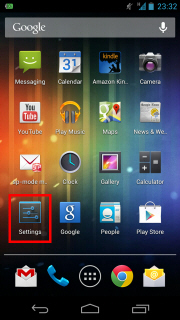
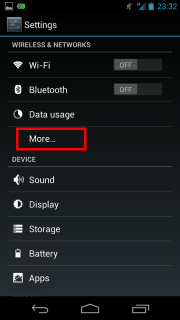
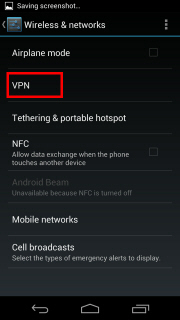
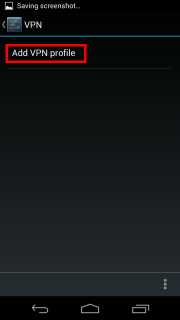
A new VPN connection setting editing screen will appear.
Input something string on the "Name" field
(e.g. "vpn" ), and choose "L2TP/IPSec PSK"
in the "Type" field.
On this screen, you have to specify either hostname or IP
address of the destination VPN Gate Public VPN Relay Server.
Open the VPN Servers List
page, and click one VPN Relay Server which you want to use.
Copy the DDNS Hostname (an identifier ends with ".opengw.net"
) or IP Address (digits as xxx.xxx.xxx.xxx) and paste it on
the "Server address" field on the
configuration screen.
- In general, DDNS Hostname (an identifier ends with
".opengw.net" ) are recommended to specify. DDNS
hostname can continue to be used even if the
corresponding IP address of the DDNS hostname will
change in future. However, in some countries or regions,
you might be unable to use DDNS hostname. If you fails
to specify a DDNS hostname, try IP Address (digits as
xxx.xxx.xxx.xxx) specification instead.

Scroll down the configuration screen, and tap the
"Show advanced options" checkbox if appropriate.
Specify "vpn" (3-letters) on the
"IPSec pre-shared key" field.
Specify "0.0.0.0/0" (9-letters) on the
"Forwarding routes" field. Make sure that
you input the "Forwarding routes" field correctly. If not,
you cannot communicate via VPN.
After all inputted, tap the "Save"
button and save the VPN connection setting.

2. Connect a VPN
You can start a VPN connection by using a created VPN
connection setting at any time. Open the VPN connection
settings list and tap a setting, you will see the following
screen.

At the first time of using, you have to input
"Username" and "Password" fields.
Specify "vpn" (3-letters) on both
"Username" and "Password" fields,
and check "Save account information" .
Tap "Connect" to start the VPN
connection.
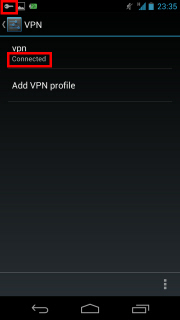
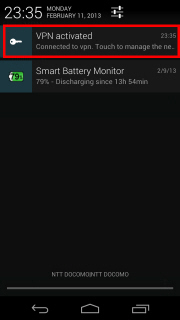
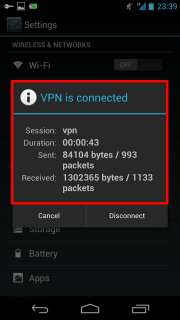
After the VPN connection will be established, the
indicate string "Connected" will be
displayed next to the VPN connection setting, and the status
indication area of Android will show "VPN activated"
message. You can tap the message to see the current status
of the VPN connection.
3. Enjoy Internet via VPN relaying
While VPN is established, all communications towards the
Internet will be relayed via the VPN Server.
You can visit the VPN Gate Top Page to see
your current global IP address. You can see your source
country or region has been changed to other if you are
connecting to a VPN server which is located on oversea
country.

Enjoy YouTube, Facebook or Twitter while your VPN
connection is established.
Facebook, Twitter and Gmail uses HTTPS (SSL) encrypted
communication protocols. Regardless of VPN or non-VPN, no
one can tap these encrypted communications.
Any errors using L2TP/IPsec VPN?
- Username, password and pre-shared key are all "vpn"
(3-letters). Especially, make sure you input the
pre-shared key correctly.
- Mac OS X and Android needs a special settings to
make the VPN server relays all traffics. Confirm the
above instructions again.
- Make sure that the destination hostname or IP
address are correct, viewing the VPN
Servers List page.
- In some countries or regions, specifying DDNS
Hostname (.opengw.net) might fail. In such an
environment, specify the IP address directly instead of
DDNS hostname.
- Your local firewall might filter any L2TP/IPsec
packets. In such a network, L2TP cannot be used. If you
use Windows, try Using
SoftEther VPN Client. Mac, iOS or Android, try
Using OpenVPN.
|